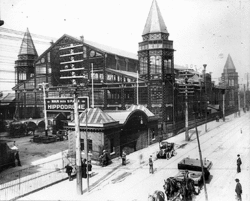Winter Garden at Exposition Hall
The Exposition was originally supposed to be a place for social gatherings where ideas and goods could be freely exchanged; however, the facility later became Pittsburgh's premier indoor ice hockey rink.
The facility had a daily average attendance of 10,000 during the fall months; visitors were attracted to the automobile, poultry and trade shows, while others gathered to enjoy the best orchestras and bands in the nation.
Meanwhile, fashion shows from New York and Paris attracted high-society women, while free samples of balloons, popcorn and dairy products captured the attention of ordinary citizens.
Finally, a roller coaster, Ferris wheel and merry-go-round helped lure the children of western Pennsylvania to the facility.
The complex had 100,000 square feet (9,300 m2) of exhibit space, an art gallery and the Music Hall that held 5,500 patrons.
The Main Hall's heavy doors were adorned with cut white stone and the interior was decorated and illuminated by 1,500 incandescent lights under a vaulted and girdered ceiling.
Even while during the last decade, public interest in such affairs was declining, the society secured large attendance every year by increasing the facility's musical attractions by booking the greatest orchestras and bands of the country.
Over the next two years, hosting an exposition was deemed impossible, due to World War I and a polio epidemic.
Hockey was a growing sport in Pittsburgh and had been played at the Duquesne Gardens, which was located in the city's Oakland neighborhood.
In 1915, chiller pipes and concrete were added to the floor of the Main Hall to create an impressive ice surface.
The Duquesne and Winter Garden teams each played out-of-town opponents, often on the same night, and in direct competition of one another.
[5] On March 24, 1917, the biggest hockey match in the Winter Garden's history took place, featuring Hobey Baker.
Pittsburgh's mayor, Edward V. Babcock, negotiated for the purchase of the Society's rights, to lease the main buildings for a union trolley freight station, and to use machinery hall for a city garage and machine shop, while the music hall could still be used for conventions and mass meetings.
The Main Hall was the last remaining building until 1951 when the structure was torn down to make way for the 37-acre (150,000 m2) Point State Park.

